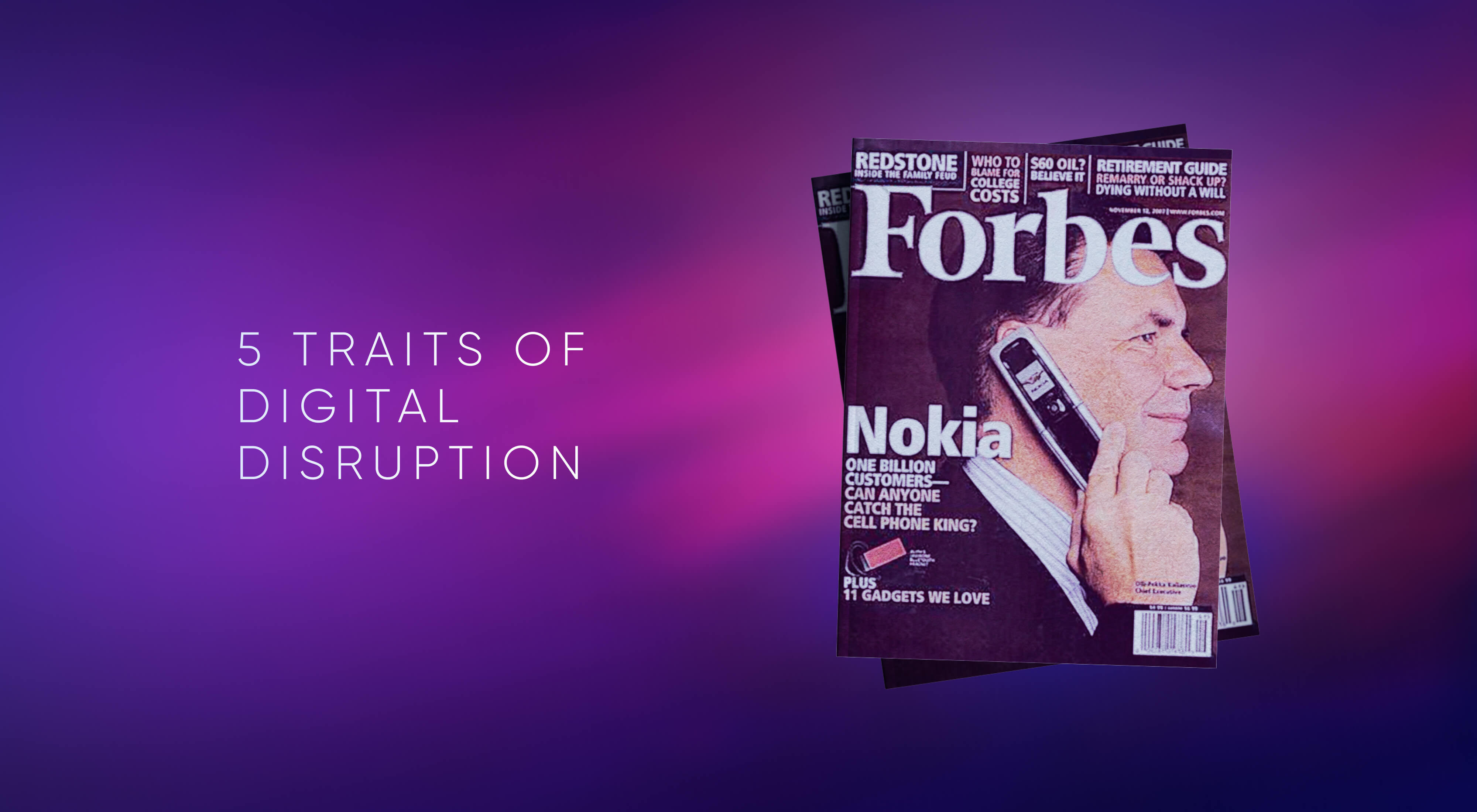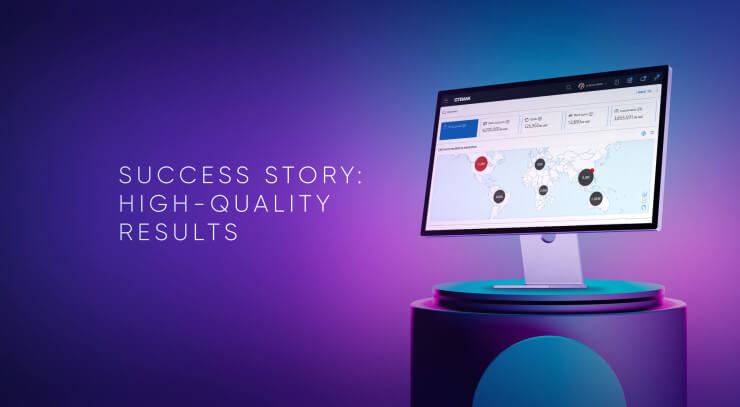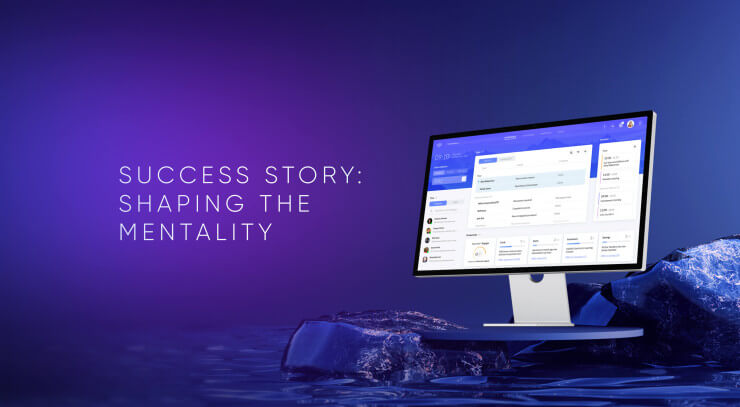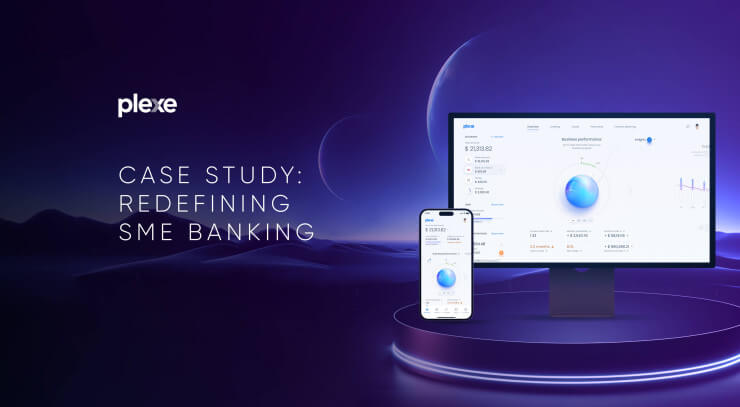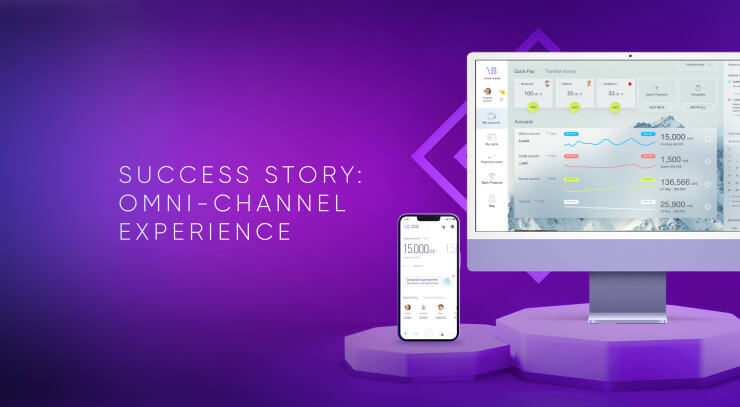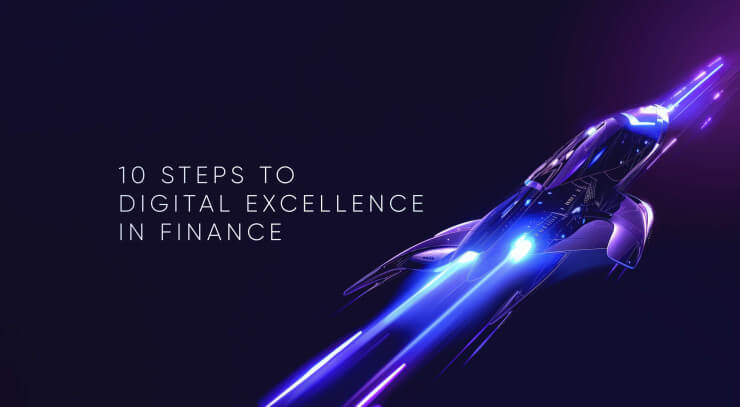Over ten years ago the Forbes magazine appeared with a title on the cover: "Nokia. One billion customers - can anyone catch the cell phone king?" At that moment nobody was expecting that 2018 will make Apple the world's first trillion-dollar company, and we can all agree that the emergence of iPhone changed the world we live in. How can design thinking approach to banking innovation contribute to the digital disruption in the financial industry?
In 2007 capitalization of Apple prior to the iPhone launch was $80 billion, Nokia being $100 billion. After five years, Nokia's capitalization fell to $10 billion, and, in 2014, the Nokia Devices and Services unit was bought by Microsoft for $6 billion to sell it in 2016 for $350 million. The Apple capitalization as of April 2022 is $2.78 Trillion.
But it doesn't always happen right away. BlackBerry continued to grow for 4 years, after Apple released the iPhone. Kodak continued to grow for 6 years, after digital cameras became available, and Blockbuster continued to grow for 7 years, after Netflix launched.
After Tesla released its first electric vehicle (EV) in 2008, Model Y became the world's best-selling car in Q1 2023. But it seems, that this time vehicle manufacturers learned their lesson and actively switching to EVs. Will it help this time? We'll see, but so far the data says that over the past two years, while Tesla has been growing, sales of the largest automakers have stalled or are falling.
As we see, market disruption often comes with a delay, and it would be interesting to see if this could happen to large companies in the financial industry.
How to Disrupt the Financial Sector Using Digital Innovation in Banking
I believe the most interesting theory explaining above mentioned situations is provided by Clayton Christensen, Harvard professor and businessman, in his famous study, “The Innovator’s Dilemma,” which “deeply influenced” Steve Jobs. In accordance with his theory, there can be two types of innovation: sustaining innovation and disruptive innovation.
The main idea is that any industry develops along the path of constant improvement, and consumers of these improvements are always the most demanding customers, and the most profitable. The problem is that the mechanisms for creating value in an organization are inherently hostile to change. Therefore, leading companies focus on meeting the most demanding customers implementing sustaining innovations.
Disruptive innovations at the beginning of their journey cannot meet the needs of major consumers because they are not developed that well, resulting in poor performance. But, disruptive innovations are becoming interesting to niche customers who prefer them based on specific criteria. e.g., price, operating conditions, key features, simplicity etc. Disrupting innovations begin their course with satisfying the needs of these small niches. Then the technology begins to develop, improve, and, at some point, they begin to approach the traditional solutions in quality. At that moment, a market disruption takes place.
Nokia was definitely an innovative company, so they achieved success. The problem was that their innovations were sustaining only. They became so powerful that they believed the market was completely under their control. Мaybe they even saw themselves as trendsetters who determine where the market would go tomorrow. The appearance of the first iPhone with a touchscreen did not alert them because it received a lot of negative reviews. The majority of consumers wasn't ready to forget about the buttons instantly.
If you look at the banking industry from this point of view, you will understand how a dangerous trap could appear. Huge bank resources, combined with a large number of different digital banking innovations they are working on today to satisfy major customers, could create the illusion of market control and future success. At the same time, true digital disruption in banking industry can go unnoticed and suddenly change the customers behaviour and the rules of the game completely.
FIVE TACTICS TO BECOME DIGITAL DISRUPTOR
What are the Opportunities and Threats of Digital Disruption in the Banking Industry
To find out what can be done, we need to understand what can characterize banking innovations that will lead to digital disruption in banking industry. Further reasoning will be based on insight from Professor Christensen book, “The Innovator's Dilemma,” which I highly recommend.
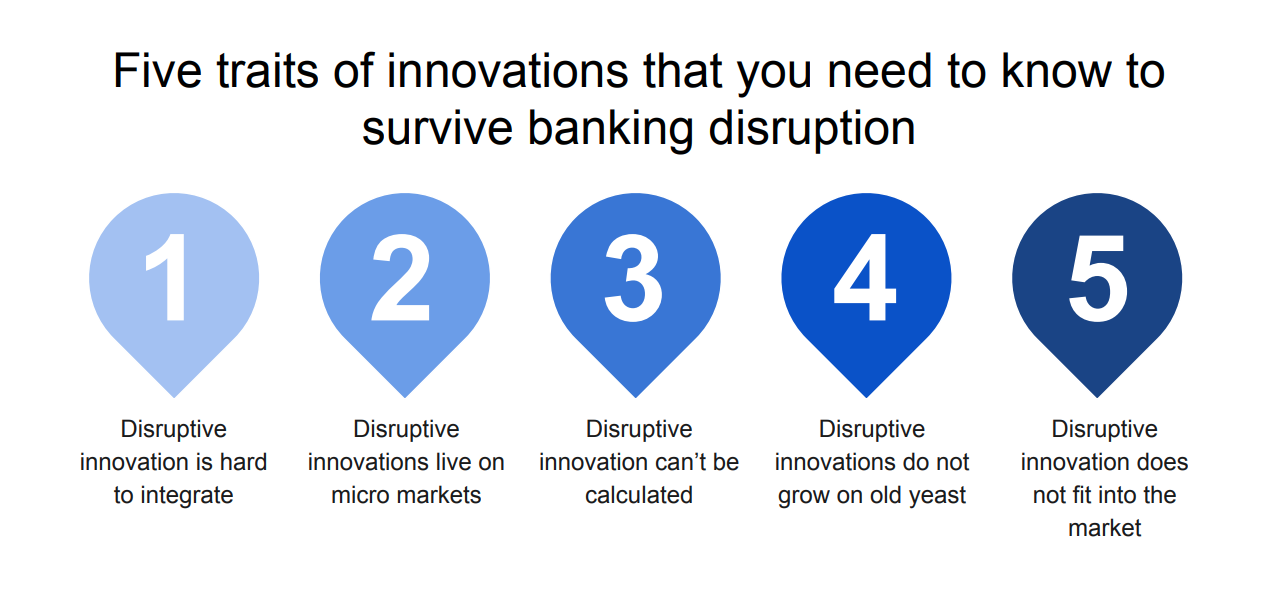
1. Keep in Mind That Disruptive Innovation is Hard to Integrate
The problem is that disruptive digital technologies offer simpler and often cheaper solutions.
For example, the team of Fintech startups offers cross-currency P2P wire money transfer app with nearly no fees. Compared to existing bank services, there is no need to fill out long forms, wait several days for manual processing of the operations or pay for these large fees. P2P Fintech innovation provides fast, automatic and fully remote service and use design thinking in banking to make it user-centered.
Unfortunately, for the common bank, it is difficult to integrate and offer such Fintech innovation to its customers. First of all, it is absolutely unprofitable because it will not even cover the cost of the bank’s infrastructure. Second, this does not correspond to the technology that banks are using, existing work processes and banking regulations. Third, such a product could look unusual and even incomprehensible to the majority of active banking users.
We saw this in 2007 when the smartphone from Apple was given critical reviews and doubts about device success from major experts and media. Only innovators were enthusiastic about the first iPhone, but they also didn’t fully understand the innovative phone's capabilities and advantages. At that time, an army of fans who constantly used other Apple products significantly helped to garner interest in the company.
The future-oriented organization should look closely at those innovations that simplify service and reduce costs, and there is still a solution for the inability to integrate them into the existing business. You need to start to develop potentially disruptive technology as a separate business, which will have a chance to fly when this breakthrough solution captures the market.
2. Grow Disruptive Innovations on Micro Markets
For large financial companies, it is important to get a significant amount of revenue from a sizable market, to show the expected growth to shareholders and cover the costs of a huge team.
If we look at the example above, even realizing the promise of this technology to the bank, it will be difficult to take advantage of it. The scale of the bank, the culture of work and the decision-making mechanisms do not correspond to the small size and flexibility requirements of the growing micro market. That's why small startup teams of several people are more likely to succeed through innovative banking.
Fintech startups are more flexible, faster and innovative than a large bank with its legacy formalities, regulations and internal competition. Of course, in this situation, a bank can wait until the market grows to enter into it. But, according to the observations of Professor Christensen, this strategy often fails.
The same approach works here as in the previous scenario. A large company can vigorously develop a potentially breakthrough market only by running an independent and small team on it ensuring flexibility and Fintech innovation approach.
3. Remember That Disruptive Innovation Can’t be Calculated
Fintech startups usually follow a strategic vision and change the service, technology and processes on the go to ensure the most rapid and effective formation of a disruptive banking technology. As we understand, it is impossible for a large bank to do and not only because of the inertia of its internal processes, which is obviously high.
Decision-making in large financial organizations is based on numbers and forecasts. This is the only way to lead these huge liners to the target and save them. But, in the case of breakthrough bank innovations, this does not work, because it is terra incognita. There are no data and no clues to predict the exact model of the market and forecast possible ROI that justifies the investment. That is why the disruptor gets a significant advantage here and, in the future, will become leaders of new markets.
Realizing this, a large organization must abandon traditional methods of evaluation and planning in case of disruptive innovation. The decision is to create small “startup-like” innovative bank teams for the work on disruptive markets. Development and management of these teams have to be based only on insights obtained and verified on the go.
4. Don't Grow Disruptive Innovations on an Old Yeast
Processes and approaches in a large financial company are focused on its highly profitable products in traditional markets. However, they are not fundamentally suitable for disruptive banking innovations. Often, not only a different approach is required, but an entirely different way of thinking.
Therefore, it is impossible to create a laboratory of disruptive technologies from the enterprise employees that don't have it in them. The disruptive team should consist of people who are not influenced by the existing banking culture and are unfamiliar with traditional banking processes. And the management of such a structure should be carried out by an independent agent of change, not connected to the traditional approach and not limited by familiar bank culture.
This is the only way to develop and master new innovative banking principles, culture and foundations that will later become the basis for success in the disruptive market, as well as a source for needed financial organization transformation.
Despite the fact that Apple was already a large corporation, Steve Jobs formed a separate and passionate team driven by a culture of innovation to create the iPhone. They didn’t have a legacy and constraints in traditional telecommunications. In fact, Jobs used his vast experience of developing successful, disruptive products.
5. Don't Try to Fit Disruptive Innovation Into the Market
Usually, the potential of disruptive technology is very difficult to detect. It is because, at the current stage, it can’t correspond to the existing level of market infrastructure and, therefore, has limitations in its use.
For example, at the start, the experience from the iPhone was limited by the internet speed and coverage, as well as a small number of useful applications. But, at some point, the necessary infrastructure was formed, and the advantages of the new technology became apparent to all.
This means that disruptive technologies usually look inappropriate and raw at the outset. From the mass consumer point of view, they do not provide sufficient quality and do not meet the existing customer needs. Moreover, favorable conditions for explosive growth of disruptive innovation should be formed in the future market.
The use of sustaining innovations to keep leading positions causes the quality of products to outperform the market request, leading to an increase in product price. At this moment, a window of opportunity opens for disruptive innovation, which could offer consumers a lower-quality niche solution at a cheaper price.
Imagine that you ask users about popular Fintech products and why they prefer them instead of their banks. Suddenly, you find that many of them are attracted by simple solutions, without over-featuring. This is despite the fact that banks created and developed complex functionality to please customers with ultra-excessive opportunities. And, suddenly, we face the fact that some users prefer to use only a few cropped, but fast, easy and cheap functions. This is how the window of opportunity for disruptive financial technology could appear, to become the standard of the industry with the engaging majority of users.
What can be done here? Track promising innovative banking technologies that offer fundamentally new and somewhat more accessible solutions for users. Take these banking technologies seriously and test them in narrow niches, releasing experimental products.
make your financial business disruption-proof
Conclusion
You may ask which digital banking innovation technologies could cause financial market disruption. Honestly, we can't know it for sure; that's why it is called disruption. It could be full-market decentralization caused by blockchain combined with P2P technology, absolute money and banking digitization provided by powerful tech companies or appearing of the global open banking platform connected with banks through API and managed by Artificial Intelligence in banking, or central wallets powered by CBDC that will ruin traditional banking model by stealing deposits from banks. We believe that financial companies have to adapt for all of this because this is a market landscape already developed by such tech giants as Google, Apple, Facebook, etc.
We also need to take into account challenger banks, that are so small today, as Facebook or Google were years ago. From the financial industry disruption perspective no one takes neo banking seriously yet. But we should track multiple probabilities, because who knows? Something we know for sure is that banks are no longer incompatible as they were before the digital age. And, as we learned from the iPhone scenario, the world of finance could change dramatically in the next 10 years because consumers behavior is changing completely nowadays. So, keep your eyes open and step aside from outdated patterns to follow changes in consumer behavior by delivering best possible user experience through digital products.
P.S.: Apple Shot the Market, but it did not Shoot Nokia
In the end, I would like to rehabilitate Apple (although they certainly do not need it) and offer another point of view on what happened 10 years ago with Nokia. Of course, the iPhone changed the phone market, and this influenced Nokia's position. But, Nokia had a chance to keep big market share by choosing the right strategy at the start of the market disruption, as vehicle companies do nowadays. They were not flexible enough to overcome the legacy and use this opportunity, but Samsung did instead.
Unlike the iPhone, Samsung's strategy more closely resembles Nokia’s - a huge selection of devices for different segments and at different prices. Perhaps, when looking at capitalization, they are not as successful as Apple, because the Google Play market does not belong to them, but, by the number of sold devices, Samsung is even slightly ahead.
Could Nokia be in this place? It seems obvious to me that they had a perfect opportunity if a touchscreen disruptive innovation was taken seriously. So, I think this is a good lesson for any company, especially in the financial industry.
Get UXDA Research-Based White Paper "How to Win the Hearts of Digital Customers":
 If you want to create next-gen financial products to receive an exceptional competitive advantage in the digital age, contact us! With the power of financial UX design, we can help you turn your business into a beloved financial brand with a strong emotional connection with your clients, resulting in success, demand, and long-term customer loyalty.
If you want to create next-gen financial products to receive an exceptional competitive advantage in the digital age, contact us! With the power of financial UX design, we can help you turn your business into a beloved financial brand with a strong emotional connection with your clients, resulting in success, demand, and long-term customer loyalty.
- E-mail us at info@theuxda.com
- Chat with us in Whatsapp
- Send a direct message to UXDA's CEO Alex Kreger on Linkedin


